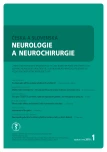Injury as a cause of extrapyramidal syndromes
Authors:
prof. MUDr. Egon Kurča, Ph.D.
Authors‘ workplace:
Neurologická klinika JLF UK a UN, Martin
Published in:
Cesk Slov Neurol N 2018; 81(1): 9
Category:
Controversions
Sources
1. Krauss JK. Movement disorders secondary to craniocerebral trauma. Handb Clin Neurol 2015; 128 : 475 – 496.
2. Krauss JK, Tränkle R, Kopp KH. Posttraumatic movement disorders after moderate or mild head injury. Mov Disord 1997; 12(3): 428 – 431.
3. Hallett M. Functional (psychogenic) movement disorders – clinical presentations. Parkinsonism Relat Disord 2016; 22 (Suppl 1): S149 – S152.
4. Van Rooijen DE, Geraedts EJ, Marinus J et al. Peripheral trauma and movement disorders: a systematic review of reported cases. J Neurol Neurosurg Psychiatry 2011; 82(8): 892 – 898.
5. Frei K. Posttraumatic dystonia. J Neurol Sci 2017; 379 : 183 – 191.
6. Lin PT, Hallett M. The pathophysiology of focal hand dystonia. J Hand Ther 2009; 22(2): 109 – 113.
Labels
Paediatric neurology Neurosurgery NeurologyArticle was published in
Czech and Slovak Neurology and Neurosurgery

2018 Issue 1
- Metamizole vs. Tramadol in Postoperative Analgesia
- Memantine in Dementia Therapy – Current Findings and Possible Future Applications
- Metamizole at a Glance and in Practice – Effective Non-Opioid Analgesic for All Ages
- Advances in the Treatment of Myasthenia Gravis on the Horizon
Most read in this issue
- A neurological view on spondylodiscitis
- Parosmia and phantosmia in patients with olfactory dysfunction
- Assessment of cognitive functions using short repeatable neuropsychological batteries
- Cavernous sinus thrombosis – still occurring complication of rhinosinusitis
